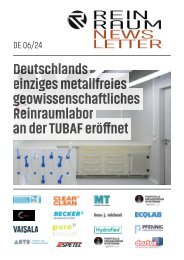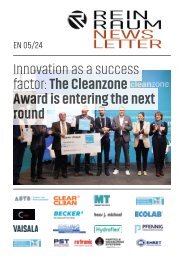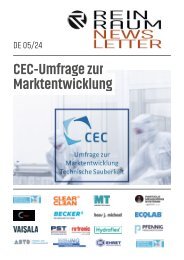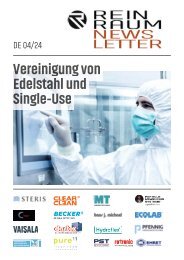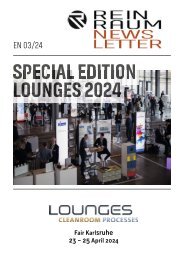Newsletter_04-2024_EN
You also want an ePaper? Increase the reach of your titles
YUMPU automatically turns print PDFs into web optimized ePapers that Google loves.
Success for a highly complex automation project
Combining stainless
steel and single-use
Whether it be stainless steel plant or single-use equipment, as a leading provider of customized automation solutions, ZETA
seamlessly integrates biopharmaceutical production systems into new or existing automation environments. A project with
a renowned life science company in Germany shows how customer-specific standards are implemented with intelligent
automation strategies. For the globally active pharmaceutical company, ZETA automated a stainless steel preparation plant
designed and manufactured in-house, as well as a filtration system from a single-use provider, integrating both systems into
the overarching process control system.
In the course of the large-scale expansion of an important pharmaceutical
production site in Germany – where drug solutions for injection
and infusion are manufactured – state-of-the-art technology
was applied to ensure the highest production standards. ZETA made
its contribution with a customized multipurpose plant consisting
of mobile preparation vessels and a cleaning station (CIP/DIP/SIP)
made of stainless steel. These were complemented by a filtration
system, developed by a single-use supplier, to minimize germ contamination
of the product.
The ZETA automation team faced various challenges, as the overall
responsibility for the automation of the two flexible systems –
stainless steel and singleuse – and their integration with the higherlevel
process control system lay in their hands.
Automation concept for a smooth process control
The ZETA experts installed the automation technology based on a
carefully developed automation concept. For this project, the Siemens
PCS7 process control system with SIMATIC Batch was used.
The application software designed for the plants was created using
the customer-specific programming guideline and the module library
specified b y t he c ustomer. D uring t he c onceptual planning
stages, special attention was paid to a high degree o f fl exibility o f t
he a utomated p rocesses. The finished software system was integrated
with the existing customer PCS7 server-client system.
Pharmaceutical production in accordance with GMP and GAMP5
Observing Good Manufacturing Practice (GMP) and complying with
standards and regulations is essential in pharmaceutical production.
Automation at ZETA follows the Good Automated Manufacturing
Practice guideline GAMP5. The creation of batch recipes and batch
records – in this project, the SIMATIC Batch software system was
used for this purpose – complies with the ISA-S88 standard for batch
control. All production plants are centrally monitored and controlled
by the process control system. The recipes are created according to
the requirements of the respective processes across all plants.
Maximum reliability in the production process
Cross-system automation architecture - stainless steel and
single-use systems running on the same controller.
As requested by the customer, automation was designed as a server-client
system with a central, redundant control system. The benefit
of redundancy lies in the fact that the “spare” system is ready
to take over operation in the event of malfunctioning, which means
that redundant systems can often prevent downtime. The automation
architecture of this extensive project has been designed in a
comprehensive way, with the stainless steel and single-use systems
programmed by ZETA running on the same controller.
In the completely virtualized process control system, both the
visualization and batch servers as well as the centralized programmable
logic controllers (PLCs) and the network infrastructure were
implemented redundantly. This ensures maximum reliability for the
production processes.
Targeted solutions for special automation challenges
Redundancy provides maximum safety during operation. However,
it was precisely this requirement for redundancy that called for special
automation know-how of the companies involved. Particular attention
had to be paid to the system redundancy S2. This specifies
the coupling of one or more devices to two redundant controllers
and must be guaranteed both physically and in the programming logic.
It is essential that the instruments and components that are to
be integrated into the bus system are also capable of S2 redundancy,
placing the highest demands on the suppliers of the components.
Additionally, during processing, different types of mobile containers
must be recognized by this redundant system and docked and
undocked from the single-use filtration unit. The undocking process
in particular presented a challenge for the ZETA automation t eam.
What’s more, the single-use filtration units are mobile, interchangeable
with each other and convertible in their mode of operation.
www.reinraum.de | www.cleanroom-online.com NEWSLETTER | Edition EN 04-2024
page 2/35











